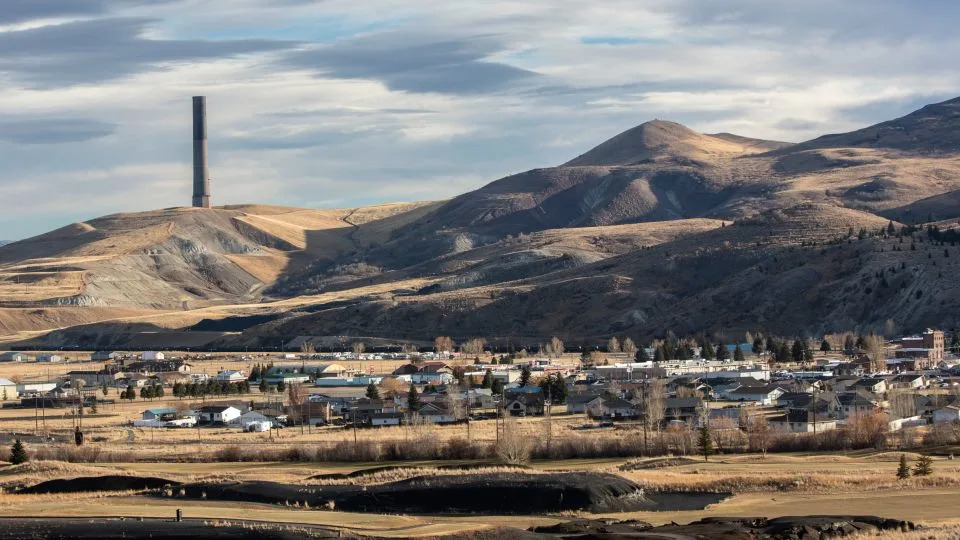
Aerial image of Kyger Creek coal fired power plant in Gallia County, Ohio. (Stock photo from Getty Images.)
This story was originally published by Canary Media.
After six years and more than a half billion dollars in consumer costs, Ohio utility customers will no longer have to subsidize two 1950s-era coal plants, one of which is in Indiana.
A new law that takes effect on August 14 officially eliminates the coal subsidies created by House Bill 6, the 2019 nuclear and coal bailout law at the heart of Ohio’s ongoing utility-corruption saga.
Despite the Trump administration’s push to keep polluting coal plants open, their electricity is generally less competitive than alternatives such as combined-cycle gas, solar energy, and wind power. These two coal plants in particular are often among the most expensive options available in the grid region serving Ohio, and yet have run anyway.
Lawmakers repealed HB 6’s nuclear bailout less than a year after the corruption scandal became public, with the arrests of former Ohio House Speaker Larry Householder and others in 2020, but multiple bills to repeal the coal plant subsidies failed. It wasn’t until HB 15 passed in May that lawmakers finally agreed to end the mandated payments — at least for the 5 million customers of Ohio’s regulated utilities.
Since 2001, customers of Ohio’s regulated utilities have had the option to choose their electricity supplier, and utilities have generally been banned from favoring or subsidizing related generation companies.
Starting in 2013, however, Ohio utility companies began seeking ratepayer-funded bailouts for the two old coal plants — the Kyger Creek plant, in Cheshire, Ohio, and the Clifty Creek plant, in Madison, Indiana — owned by the Ohio Valley Electric Corporation, or OVEC. OVEC’s shareholders are parent companies of Ohio’s regulated utilities.
The Public Utilities Commission of Ohio, or PUCO, let some utilities begin collecting charges in 2017, but those orders faced challenges. Two years later, HB 6 guaranteed those payments through 2030.
SUBSCRIBE: GET THE MORNING HEADLINES DELIVERED TO YOUR INBOX
The subsidy cutoff comes none too soon, according to an August 4 analysis prepared by RunnerStone for the Ohio Manufacturers’ Association. Ohio utility customers could have paid over $413 million more through 2030. As things stand, the HB 6 subsidies plus earlier payments under challenged regulatory orders total more than $683 million, the analysis shows.
“Instead of propping up shareholders, this money should have gone to help Ohio’s families pay for needed items like groceries, health care, and other essentials,” said Maureen Willis, who serves as Ohio Consumers’ Counsel. As she sees it, “ending the coal plant subsidies is long overdue.”
Yet controversy continues over whether large chunks of the charges were reasonable and prudent, as required by Ohio law.
One case at the Ohio Supreme Court deals with amounts collected in 2018 and 2019. Another appeal challenges the PUCO’s approval of charges in 2020 under HB 6. Both cases are waiting for the Ohio Supreme Court to schedule oral argument.
The Ohio Manufacturers’ Association Energy Group, and the Ohio Environmental Council, and the Office of the Ohio Consumers’ Counsel are challenging the utilities’ decision to pass along the costs of running the old coal plants full tilt even when it was uneconomical, among other things.
Challengers in the HB 6 case argue that the PUCO rulings improperly presumed that the coal plant charges were lawful, instead of making the utilities prove it. The commission then limited challengers’ ability to show that the costs for running the plants during poor market conditions failed to meet statutory requirements, they say.
The case for the 2018 and 2019 charges also includes an argument that the commission improperly influenced an independent audit. For instance, a commission staff member asked the auditor to “tone down” a draft report saying that the plants’ must-run strategy was not in the best interests of ratepayers.
Beyond that, a pending regulatory case will examine the coal plants’ costs from 2021 to 2023. And a July 31 filing by the Ohio Manufacturers’ Association Energy Group and the Office of the Ohio Consumers’ Counsel has asked the public utilities to open a case to review the coal plant charges for 2024 and 2025. The commission has not yet ruled on the request.
Meanwhile, spokespeople for American Electric Power and FirstEnergy told Canary Media their Ohio utilities will no longer include the coal charge on bills after August 14.
Others still paying
Due to a 2011 agreement among OVEC’s shareholders, both plants intend to keep operating until 2040.
So while customers of Ohio’s regulated utilities will no longer have to pay for the OVEC plants, other consumers will continue to bear the costs, said Neil Waggoner, who heads the Sierra Club’s Beyond Coal program in the Midwest.
Those include the more than 380,000 homes and businesses that get their electricity from Ohio’s Electric Cooperatives, whose supplier is Buckeye Power.
Buckeye has an 18% share in OVEC, the next largest after AEP’s stake of roughly 39%. Elsewhere in the Midwest, Michigan’s public service commission recently disallowed more than $2 million in expenses charged by AEP’s Indiana Michigan Power for the same OVEC plants, while a July 23 ruling requires ratepayers in Indiana to pick up those costs.
Environmental costs from the plants also continue. Since 2020, the Ohio Consumers’ Counsel estimates, the plants have spewed more than 63 million tons of carbon dioxide. The plants also emit nitrous oxides, sulfur dioxide, and particulate pollution that can cause health problems for those living downwind.
“That is a lot of dirty air,” Willis said, adding that “consumers got the bill, while the environment and public health paid the price.”
Both the Kyger Creek and Clifty Creek plants cleared PJM’s capacity auction last month, which will pay generation facilities roughly $329 per megawatt/day starting in June, said American Electric Power spokesperson Scott Blake, who also speaks for OVEC.
But even with the subsidies phasing out for many Ohio utility customers, Waggoner said that the bad business decision to keep these coal plants running has gotten even worse.
“These plants are really old industrial facilities,” Waggoner said. “They’re at the end of their lives. It’s time for these plants to be retired or replaced.”








Comments